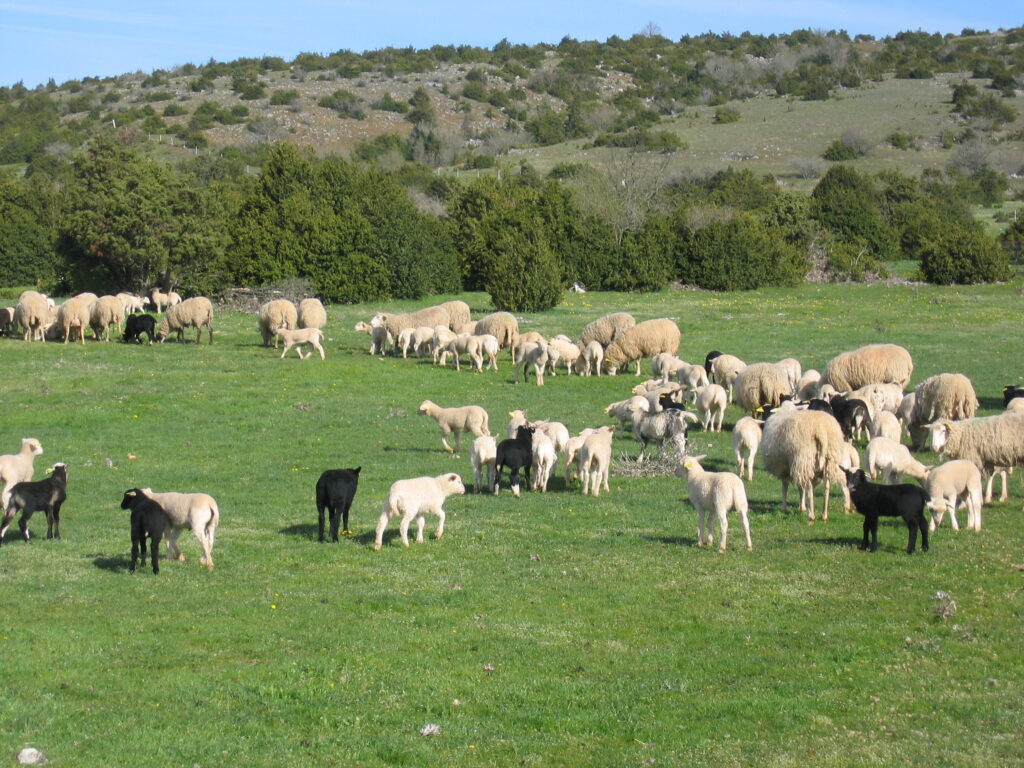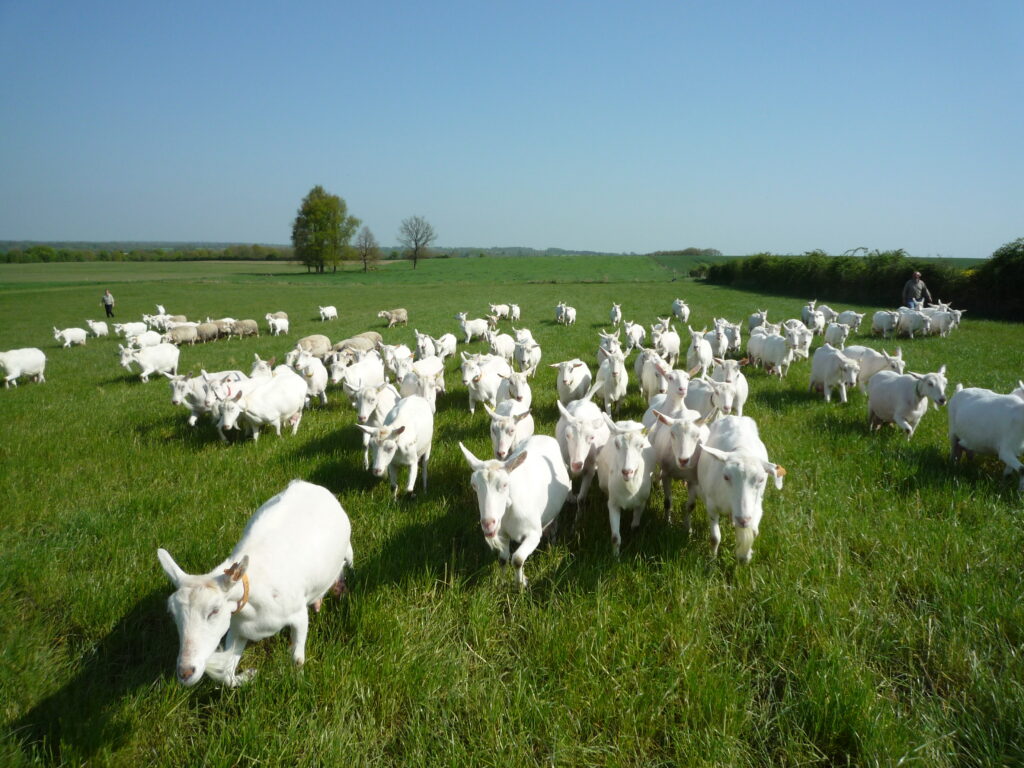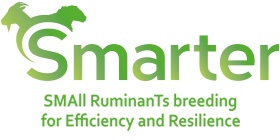
This project has received funding from the European Union’s Horizon 2020 research and innovation programme under grant agreement No 772787.
EAAP SMARTER presenters 2023!
The following presentations will be made during the 74th EAAP annual meeting to be held in Lyon on 30th August 2023.
Improving feed efficiency in meat sheep increases CH4 emissions measured indoor or on pasture.
F. Tortereau, J.-L. Weisbecker, C. Coffre-Thomain, Y. Legoff, D. François, Q. Le Graverand, C. Marie-Etancelin
Alpine goats divergent for functional longevity differ in metabolic profile during transition period
Pires, T. Fassier, M. Tourret, N. Friggens and R. Rupp
INRAE, UCA, VetAgro Sup, UMRH, 63122, Saint-Genès-Champanelle, France
Domaine de Bourges, INRAE, Osmoy, 31326 France
UMR 0791 MoSar, INRAE, AgroParisTech, Université Paris-Saclay, Paris, 75005 France
GenPhySE, Université de Toulouse, INRAE, Castanet Tolosan, 31320 France
The objective was to study associations among functional longevity and plasma indicators of metabolic adaption in Alpine goats during periparturient period. Two Alpine goat strains divergent for longevity (LGV+ and LGV-) were produced by AI selecting for extreme functional longevity but nondifferent milk yield. A total of 174 primiparous goats were studied in 2018, 2019, 2020 and 2021. Jugular plasma collected on wk -4, -3, -2, -1 relative to expected parturition, and wk 1, 2, 4, 13, 24, 33 of lactation was analyzed for NEFA, BHB, glucose, urea and bilirubin. Data were analyzed using SAS mixed models with repeated measures, including strain, litter size (LS), wk, and interactions as fixed effects, and year and goat (year) as random effects. Significant wk effects were observed for all metabolites. LGV- goats had greater plasma NEFA on wk-3 (181 vs 123 µM; strain x wk prepartum: P= 0.05), and greater BHB prepartum (0.45 vs 0.41 mM; strain effect: P = 0.04) than LGV+, which denotes greater fat mobilization and partial oxidation in late gestation in LGV-. 35% of goats carried multiple fetus (LS2+) and LS not differ with LGV. Prepartum plasma NEFA, BHB and bilirubin were greater for LS2+ compared to single (LS1; P < 0.001; 260 vs 174 µM; 0.51 vs 0.39mM; 0.069 vs 0.056 mg/dL, respectively), whereas glucose was lower for LS2+ (P < 0.001; 49.8 vs 54.7 mg/dL). Conversely, plasma NEFA was greater for LS1 during wk 1 and wk 2 postpartum (P < 0.05; 558 vs 442 on wk 1, and 421 vs 330 µM on wk 2, respectively), reflecting greater availability of body reserves to support lactation in LS1. Prepartum incidence of BHB > 0.80 mM was significantly greater for LS2+ than LS1 (30 vs 3.7%), and for LGV- carrying LS2+ than LGV+ carrying LS2+ (42 vs 28%). Marked LS effects were observed in plasma metabolite profiles in primiparous goats. LVG strains differ in their metabolic adaptations peripartum.
This study has received funding from the EU H2020 research and innovation program under grant agreement No 772787 (SMARTER) and from APISGENE (ACTIVEGOAT).
Effects of sire and diet on rumen volume and relationships with feed efficiency
N.R. Lambe, A. McLaren, K.A. McLean, J. Gordon, J. Conington
Selecting feed-efficient sheep with concentrates alters their efficiency with forages and behaviour
C. Marie-Etancelin, J.L. Weisbecker, D. Marcon, L. Estivalet, Q. Le Graverand, F. Tortereau
Blending multivariate models to predict feed efficiency and explore multiple omics in meat sheep
Le Graverand, Q.1, Tortereau, F.1, Marie-Etancelin, C.1, Meynadier, A. 1, Weisbecker, J.L.1, Lê Cao, K.A.2
1 GenPhySE, Université de Toulouse, INRAE, ENVT, 31326, Castanet-Tolosan, France;
2School of Mathematics and Statistics, University of Melbourne, VIC 3010, Australia
Selecting sheep for feed efficiency would improve the sustainability of sheep farming by decreasing feeding needs. However, due to the costs of recording feed intake, feed efficiency is rarely selected in sheep. Identifying feed efficiency biomarkers could help resolve this issue. A total of 258 Romane male lambs were phenotyped in the growing period for Residual Feed Intake (RFI) – in three different batches. Rumen fluid and blood were sampled as potential sources of biomarkers for feed efficiency. Multivariate analyses were performed with six distinct ‘blocks’ of predictors: fixed effects and covariates (FC), genotypes (SNPs), plasma NMR spectra (NMR), ruminal volatile fatty acids (VFAs), long-chain fatty acids (LFAs), bacteria and archaea abundances (16S amplicon sequencing). We modified a Partial Least Square regression approach (PLS) to account for the three batches while selecting biomarkers of feed efficiency (Rohart et al., 2017). Cross-validation was repeated to fit one model per block on our training data (60% of the samples). Then, predictions for the validation set (30% of the samples) were obtained by using a weighted aggregation – based on the performance on each validation set. Testing data (10%) were independently used to assess the overall prediction accuracy based on Pearson correlations. When RFI was predicted from separate blocks, the average accuracy was low to moderate: 0.08 (standard deviation: 0.17) from VFAs to 0.44 (0.13) from SNPs. When RFI was predicted with our approach combining different omics, accuracy increased and reached an average of 0.55 (0.11). Based on weights attributed to blocks of predictors, we were able to rank the most predictive blocks to explain RFI: SNPs, FC, NMR, 16S, LFA and VFA. Furthermore, within each block we identified variables that were highly associated with feed efficiency RFI, including β-hydroxyisovaleric acid and a SNP located on the chromosome 3. To conclude, blending models is useful to integrate heterogeneous omics data: from predicting efficiency, to identifying associations between multi-omics predictors.
This study has received funding from the European Union’s Horizon 2020 research and innovation program under grant agreement No 772787 (SMARTER)

Romane sheeps © INRAE
Genome-wise association study of footrot and mastitis in UK Texel sheep
K. Kaseja, S. Mucha, J. Yates, E. Smith, G. Banos, J. Conington
Genetic parameters of nematode resistance in dairy sheep
B. Bapst, K. Schwarz, S. Thüer, S. Werne
Phenotypic and genetic variability of health and welfare traits in French dairy goats
I. Palhiere1, A. Bailly-Salins2, A. Gourdon2, M. Chassier3, R. De Cremoux3, M. Berthelot4, R. Rupp1
GenPhySE, Université de Toulouse, INRAE, INPT, ENVT, 31326 Castanet Tolosan, France
Capgenes, 2135 Route de Chauvigny, 86550 Mignaloux-Beauvoir
French Livestock Institute, 149 Rue de Bercy, 75595 Paris Cedex 12, France
French Agency for Food, Environmental and Occupational Health and Safety (Anses), Ploufragan-Plouzané-Niort Laboratory, Unit Pathology and Welfare of Ruminants, 60 rue de Pied de Fond, Niort, 79024, France
The objective of the study was to investigate the phenotypic and genetic variability of health and welfare traits in French dairy goats. A total of 1,977 primiparous goats of Alpine and Saanen breeds, from 14 farms, were involved in the study during the years 2020-2021. Eleven indicators were assessed individually and once for each goat: abscess, arthritis, nasal discharge, ocular discharge, dirty and light soiling hindquarters, lameness, body condition, bag-shaped udder, dehorning issues, hair coat condition, claw issues. For the study, all the indicators were considered as binary traits (0: absence of disorder; 1: presence of disorder). The total number of disorders per animal was defined as the sum of the disorders for the eleven indicators. The disorder frequency ranged between 0.5% and 23% depending on the 11 indicators. Two groups of indicators were observed: those with a frequency lower than 5% (N=7) and those with a frequency about 20% (N=4: dehorning issues, bag-shaped udder, abscess, claw issues). The total number of disorders per goat was 0.94, on average in the total dataset, and ranged between 0 and 5. 40% of goats showed no disorder. Heritabilites were estimated using linear models for 4 traits suspected to be under genetic control and with sufficient frequency (>5%). They ranged between 4% (abscess) and 26% (bag-shaped udder). Arthritis and the total number of disorders had intermediate values (11% and 15%, respectively). These first results suggest that selection may be a potential strategy to improve health and welfare traits in dairy goats.
This study has received funding from the European Union’s Horizon 2020 research and innovation program under grant agreement No 772787 (SMARTER)

Saanen goats © CAPGENES
Contrasting genetic resistance to GIN on growth performance and feed efficiency of Corriedale lambs
E.A. Navajas, G. Ciappesoni, I. De Barbieri
Australian Merino: animal welfare and resilience in extensive systems
M. Del Campo, J.L. De Araújo Pimenta, I. De Barbieri, P. Lorenze, F. Rovira, J.M. Soares De Lima
Assessment of phenotypic and genetic variability of rumen temperatures in goats
I. Palhiere1, C. Huau1, T. Fassier2, R. Rupp1, L. Bodin1
GenPhySE, Université de Toulouse, INRAE, INPT, ENVT, 31326 Castanet Tolosan, France
P3R, INRAE, 2018. Small Ruminants Phenotyping Facility, doi.org/10.15454/1.5483259352597417E12, Osmoy, F-31326, France
The aim of this study was to identify the factors of variation of rumen temperatures in goats and to estimate the genetic parameters of that trait. 97 Alpine goats from an INRAE experimental farm were monitored continuously during their first lactation (267 days on average, from kidding to dry off) using Medria rumen temperature boluses (ThermoBolus San’Phone®). Temperatures were collected every 5 min (288 records per day) and have been corrected to account for drinking events. The average rumen temperature was 39.68 ± 0.51°C on the whole data set (n=7,273,000). The average temperature during the day increased from about 5.00AM to about 5.00PM and decreased afterwards: the minimum temperatures (39.28°C) were observed in early morning (between 5.00AM and 5.30AM) whereas the maximum temperatures were observed in late afternoon (39.94°C between 4.30PM and 5.00PM). In addition to the time, the phenotypic variability was also explained by the date, the birth year, the stage of lactation and the milk yield of the goat. Genetic parameters were estimated using a linear repeatability model. Data were spread into 5 periods according to their raw mean temperature and standard deviation (4.30AM-6.00AM, 6.40AM-1.20PM, 3.30PM-8.00PM, 9.00PM-3.00AM) and each one was analysed separately. Repeatability varied from 0.20 (4.30AM-6.00AM) to 0.32 (3.30PM-8.00PM), and heritability from 0.03 (4.30AM-6.00AM) to 0.12 (9.00PM-3.00AM). For this last period, breeding values ranged from -0.10 to +0.14 °C. These results suggest that body temperature measured by internal sensors has a genetic control, which is potentially linked to basal metabolism or response to various stressors (heat stress, infection).
This study has received funding from the European Union’s Horizon 2020 research and innovation program under grant agreement No 772787 (SMARTER)
Heritability of novel metabolite-based resilience biomarkers in dairy goat
M. Ithurbide, T. Fassier, M. Tourret, J. Pires, T. Larsen, N.C. Friggens, R. Rupp
Genetic parameters for grazing behaviour traits of Boutsko sheep
S. Vouraki, V. Papanikolopoulou, A. Argyriadou, V. Fotiadou, V. Tsartsianidou, A. Triantafyllidis, G. Banos, G. Arsenos
Genomic signatures of adaptive response driven by transhumant pastoralism in native Boutsko sheep
V. Tsartsianidou, S. Vouraki, P. Papanikolopoulou, G. Arsenos, A. Triantafyllidis
Genetic link between fertility and resilience in sheep and goat divergent selection experiments
R. Rupp1, C. Oget-Ebrad1, S. Parisot2, T. Fassier3, G. Tosser Klopp1, S. Freret4
1GenPhySE, INRAE, Université de Toulouse, ENVT, Castanet Tolosan, France
2UE0321, Domaine de La Fage, INRAE, ROQUEFORT SUR SOULZON, France
3P3R, Small Ruminants Phenotyping Facility, INRAE, Osmoy, France
4 PRC, INRAE, IFCE, CNRS, Université de Tours, Nouzilly, France
The challenge for breeding is to improve resilience traits simultaneous with efficiency and reproduction. However very little information exits about possible trade-off between resilience and reproduction in small ruminants. The aim of this study was to investigate such possible trade-off in four divergent selection experiments in dairy sheep and goat. In each experiment we analyzed the success to artificial insemination (AI) using dates of AI and natural mating for return to estrus and dates of lambing/kidding. The first experiment was a divergent selection in Lacaune sheep on mastitis (SCS). The second was an experiment in Lacaune sheep selected for the SOCS2 gene associated to susceptibility to mastitis, with favorable (CC) and unfavorable (CT and TT) genotypes. The third experiment was a divergent selection in Alpine goats on mastitis (SCS). The fourth experiment was a divergent selection in Alpine goats on longevity. The data included 1254, 5375, 481, and 305 females and 3671, 5375, 788, and 617 AI events, respectively – and the fertility rate in these four experiments was 68.8, 70, 51.9, and 59.4%. We further estimated the odds ratio (OR) for success to AI using a logistic regression according to the genetic line, with year and lactation number as fixed effects. No effect on AI fertility was associated with selection on longevity in goats or mastitis (SCS) in sheep. However, an important favorable effect on AI fertility was associated: i) with divergent selection on mastitis (SCS) in goat: ORSCS- vs. SCS+ =1.65 (1.22-2.23) and ii) SOCS2 genotype in sheep: ORCC vs. Tx=1.36 (1.08-1.70). The results suggest that selection for resilience in dairy sheep and goats is not associated with an adverse effect on reproduction in these species. On the contrary, selection for some resilience traits seems to drive significant beneficial effects in terms of fertility after AI.
This study has received funding from the European Union’s Horizon 2020 research and innovation program under grant agreement No 772787 (SMARTER)

Laucane sheeps © INRAE
Prediction of feed efficiency related traits from plasma NMR spectra.
A. Marquisseau, F. Tortereau, N. Marty-Gasset, C. Marie-Etancelin, Q. Le Graverand
Metabolism in lambs from two feed-efficiency genetic lines subjected to different early rearing prac
G. Cantalapiedra-Hijar, M.M. Milaon, S. Parisot, C. Durand, M. Vauris, F. Tortereau, C. Ginane

